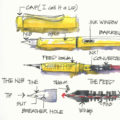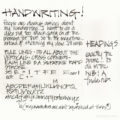
Every trip there are a handful of sketches that become the signature images from the trip. Despite the long and varied itinerary of my recent 8 week trip to Italy and the UK and the many sketches that I am happy with, there is one sketch that springs to mind – this sketch of Santa Maria della Salute in Venice.
I was extremely hot and tired at the time but yet the sketch just flowed out and appeared on the page. I was totally in the groove and was simply responding spontaneously to the building.
It was a wonderful feeling – but it’s one that I certainly don’t have every time I sketch!
I work extremely hard developing my eye hand coordination, trying different techniques that help me to be more spontaneous and I’m always pushing myself so that I get this feeling more often. I think a lot about what works and what doesn’t, and I’m constantly testing out new strategies for getting the right balance between looseness and accuracy. (Note: I will be sharing a lot of the tricks I use to sketch architecture quickly in my upcoming SketchingNow Buildings online course – techniques that have taken years and many many sketches to develop.) So please don’t ever think that the speed and freedom of my sketches comes easy – I work very hard to make it look that way.
Please also don’t think that I never make a error when I am sketching.
When I sketch complex building my sketch records my initial exploration – so it contains a lot of minor adjustments as I make discoveries along the way.
Just for the record, I made two ‘big mistakes’ (speaking with my architect’s hat on) during this sketch – one I was able to correct as I worked and the other one I lived with. But ultimately as long as the end result is ‘accurate enough’ in the essential relationships, I am happy and the error in this sketch is hardly noticeable now – it was simply a proportional distortion.
I am more and more convinced that:
The sign of being an experienced artist is not that you don’t make mistakes but rather that you have strategies in place to respond when they occur.
Having a healthy attitude to mistakes – that they are an important part of improving and that they are a fun challenge – is critical to enjoying sketching.
So what’s your attitude to mistakes? And when was the last time you felt in the groove?







22 Comments
You are a real person! Thanks for that great description about the above sketch. That is a fabulous sketch and you can tell you were in the “groove” because it fairly lives on that page. The comment you made about recognizing an error and being able to respond to it was fabulous. It makes all the difference between keeping a piece of work and throwing it in the bin!
That is a gorgeous painting and deserves a mat and frame! Thank you for describing your process and all the hard work that has gone into all you have achieved. I eagerly look forward to your posts.
I love this sketch and also your thoughts on mistakes! I did a painting once of some columns in the ruins of Pompeii. Not until I had gotten WELL into it, did I realize my depiction of them was leaning a bit, while the originals stand straight and true. But…I figured people looking at my painting will see them as ruins, so leaning a bit does not seem odd anyway! I left them as is, and many people have complimented the painting while none have challenged the “leaning columns”! Thank you for your inspiration and encouragement!
Thanks for this post! We get caught up in perfection and that is always a rabbit hole that tends to choke off flow and risk-taking. Oh, I make mistakes in everything I draw, I am sure. Just releasing them, making little corrections and adjustments allows me to move on to the next sketch. I can learn from one bit of error and then use that knowledge to help in another sketch. I really love it when you show us how to look at our sketches, see mistakes and learn from them. Thanks!
For me, mistakes help me to learn and continue to develop my style – we learn by our mistakes, as they say. I last felt ‘in the groove’ when I was holiday recently and I was able to go out sketching every evening once the children were in bed, I seem to much prefer sketching outdoors rather than back at home with the photos, even though I still sketch every day when at home.
I have loved following your blog posts about visiting the UK (where I live) – I have looked forward to each and every one and look forward to the next ones.
yes David – we can’t learn and develop without the mistakes and agree with you outside sketching is much better, but any sketching will do. SO glad you enjoyed the posts.
Good article, fabulous sketch. You should highlight the “the sign of being an experienced artist is not that you don’t make mistakes but rather that you have strategies in place to respond when they occur.”
Absolutely true (and only to be achieved by lots of practising and experimenting).
great point Rene – just made it bold!
and I guess mistakes are sign of progress and part of process
exactly Ania!
I always tell my sketching buddies that no one is comparing your drawing of the building to the actual building. That is not the point, anyway. It’s amazing and delightful to see what can be done with a building (buildings and cars are my fav subjects) when we draw, paint, them! A thousand different works of art can be created from one subject. I find it something of a miracle.
Exactly Carol! Although there is an element where we want our sketch to be ‘accurate enough’ and what that means is rather personal!
I make mistakes all the time when I sketch, especially when I am on location. Sometimes I think that maybe the on-location approach is not for me – there are way too many things to negotiate when I am out and about. I tend to get upset when I look at my page right after the fact, but if I let the page sit for a while, I can see things that I like also. So I keep going …
oh! don’t give up Mona . My sketches are riddled with mistakes all the time… and after the event its all so much better
One of my favorite sketches that you have done, Liz.
So beautiful.
thanks Annie!
I tend to make more mistakes when I’m out sketching, but at the same time I really enjoy being outdoors and sketching in natural light too (rather than in loungeroom using a photo I’ve taken). My problem is colour. I guess I need to brush up (pardon the pun) on colour theory…
yes- agree – more fun but more mistakes as well. the former is more important to me!
Constantly making mistakes ALMOST led to me giving up drawing until I read this saying “There Is No Such Thing As Art Police”. It made me put things into perspective and realise that I was the only one who was judging me.
I also adopted Tommy Kane’s attitude – if you work in pen you can’t rub it out, so learn to make your “mistake” part of the drawing. I have adopted that approach, but it’s also made me work much harder on the hand-eye co-ordination, so that’s a great outcome. I’ve totally overcome the “fear of mistakes”. And Liz, always in the back of my mind is your pearler : “Embrace The Wonky” ….. and I do.
Liz I have to say, your watercolour work is inspirational, but you have become the master of shadow – your innate ability to apply the right colour in the right tone is exceptional. Thank you for being a constant inspiration.
thanks Diane – and that is a great quote about the art police. Why does everyone take art so seriously. I totally agree about working slow and focusing on eye-hand coordination is so important. (agree but I can’t work slow so I have to improve my eye-hand by working lots!)
Wabi Sabi – the “perfectly imperfect” – I am a BIG believer. That’s what puts the feeling and then personality in your image!
NEWSLETTER
Subscribe for first notification of workshop + online classes and more.